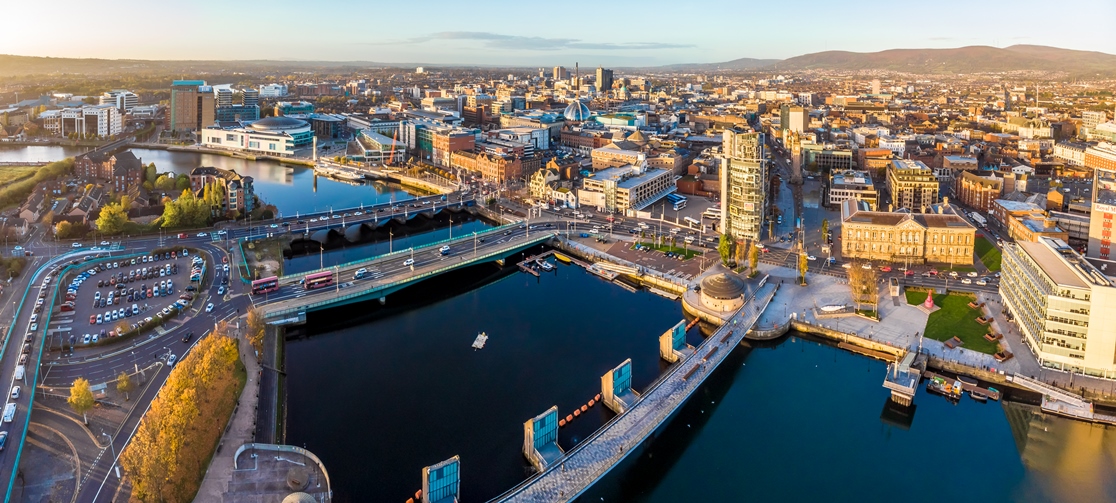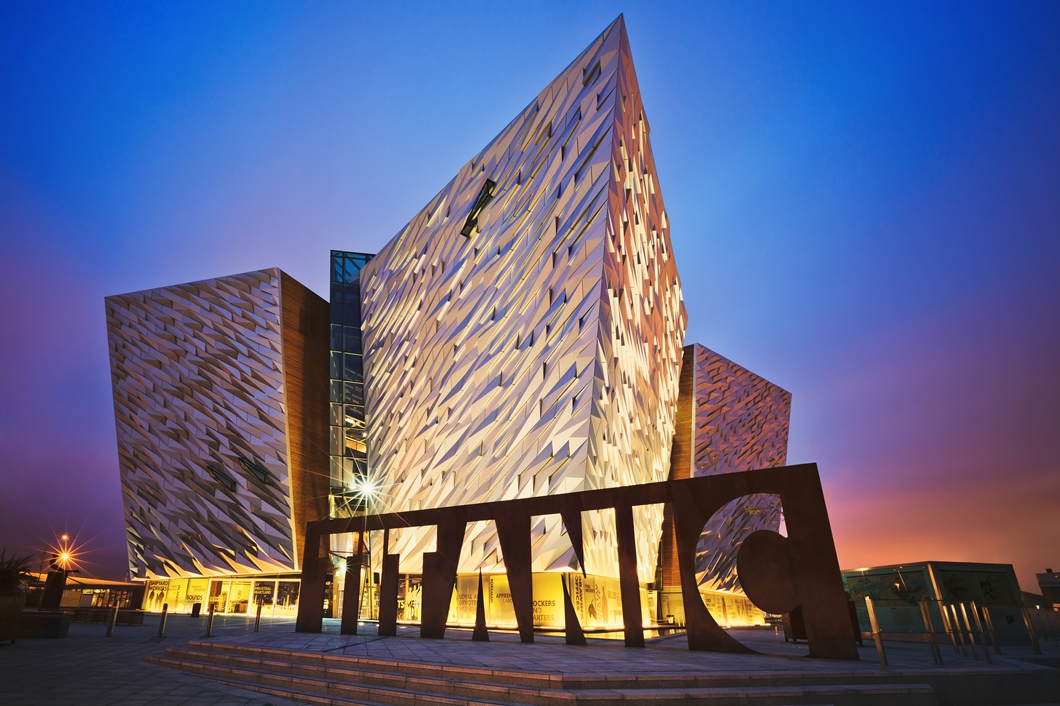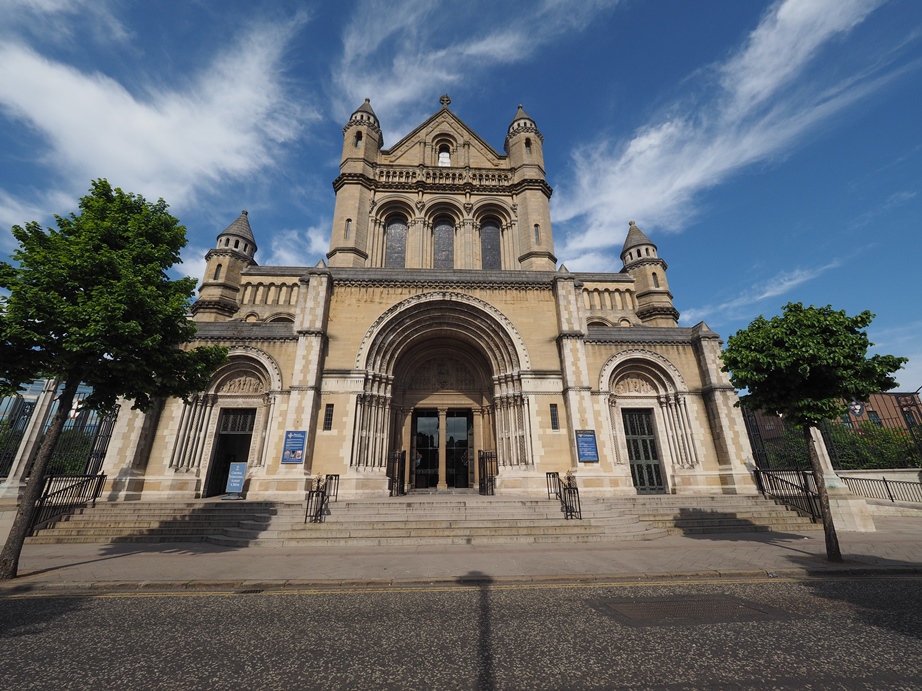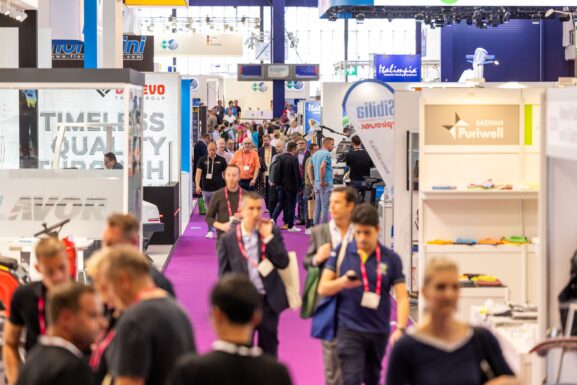FEIBP 63rd Congress Preview: Guide to Belfast

By Gwyneth Bowen
Fáilte! Welcome to Belfast host city of the 63rd annual FEIBP Congress. The event will be held September 20-22, with a program that features two days of sessions plus plenty of outstanding opportunities to take in Belfast attractions before, during and after the Congress.
The keynotes will feature Dorcas Crawford, one of Northern Ireland’s well-known business leaders who will share her expertise on being a leader and Emma Trevor of Valpak who will cover the ever-changing aspects of EPR in manufacturing and also participate in the Friday Brush Forum. The flow of the event will be enhanced and facilitated by its location at the Europa Hotel.
Opened in July 1971, the Europa was built on the site of the former Great Northern Railway station. During The Troubles, the hotel was where most journalists stayed and was known as Europe’s most bombed hotel, having been targeted 33 times between 1970 and 1994. Today the Europa is part of the peace story of Northern Ireland and has transformed into an iconic symbol of Belfast’s survival as well as an outstanding place to stay with one of the best Afternoon Teas in the city. Their Piano Bar is also a local favorite. The Europa sits in the City Centre (less than 3 square km, 1 square mile), which is home to many iconic buildings and attractions.
Belfast is the most populous city in Northern Ireland and geographically covers 115 square km (44 square miles). Belfast’s name is derived from the Gaelic Béal Feirste (Mouth of the Sandbank [or Crossing of the River]). The city’s modern history began in 1611 when Baron Arthur Chichester built a new castle there and received a charter of incorporation in 1613.
Belfast’s symbol, a seahorse, is featured on their coat of arms along with bells, a ship and a chained Irish wolfhound. The sea, ships and seahorses center around aspects of the city’s history, however, the earliest known use of a seahorse image in Belfast was on tokens used for travels. Since the seahorse was originally a symbol of good fortune and protection that would naturally be welcome to those traveling by boat or ship. Seahorses can be spotted around the city, including the seahorse sculpture at Belfast’s port and the glowing seahorse logo on the side of the lofty Grand Central Hotel.
In the 1800s, industry in Belfast was booming. Known for shipbuilding, other industries included the production of rope and tobacco. By the end of the 1900s, the city also paved the way in the world’s linen industry, was recognized as the world’s linen capital and carried the nickname Linenopolis. Many of the era’s linen houses were in the district now known as the Linen Quarter which is located behind City Hall and includes the Crown Bar, Grand Opera House, Ulster Hall, May Street Church and St. Malachy’s Church.
During the 1900s Belfast produced the most famous ship built, the RMS Titanic. When completed, it was longer than the height of the world’s tallest building at just under 269 m (882+ feet) in length. The Titanic was to be the heaviest manmade moveable object the world had ever seen, weighing in at 46,328 tons.
On Friday evening delegates and partners will enjoy an opportunity to explore the world-class Titanic Experience before enjoying the Gala Dinner at the same site. The Titanic Experience is not what Hollywood movies have portrayed but rather an immersive journey through the construction of the immense ship, literally from top to bottom. Visitors “become” part of the team of builders experiencing the sights, sounds, smells and stories that were part of the ship’s construction.
When arriving at The Titanic Experience museum, one is immediately awestruck by its exterior which is a life-size replica of the ship’s hull. The building is located beside the Titanic Slipways, the Harland & Wolff Drawing Offices and Hamilton Graving Dock — the very place where the Titanic was designed, built and launched. It will be both a memorable evening and a grand finish to time together at the Congress.

While the program is full and includes visits to Belfast attractions some additional locations are walkable from the Europa. Next door is the Grand Opera House, Northern Ireland’s premier theatre. Established in 1895, it hosts a range of drama, opera, dance, comedy, pantomime, musicals, family and West End productions with shows daily.
In the opposite direction is Ireland’s second tallest building, Grand Central Hotel, which is only a five-minute walk away. Standing 23 floors high (80m/262.5 feet), makes the luxurious Observatory Bar on the top floor the highest location for a bar in Ireland, with some of the most spectacular city views you’ll ever see.
Also in the City Centre area ten minutes away is one of Belfast’s oldest markets and one of the best in the U.K., St. George’s Market. Between the Market and the Europa are City Hall and May Street Church.
Belfast City Hall is Belfast City Council’s civic building. Inside City Hall, an experienced tour guide will take you around the Hall imparting its history while you’re exploring its finest features. The grounds include the Titanic Memorial Gardens, a tribute to the 1,512 people who perished on the Titanic.
May Street Presbyterian church was built in 1829 for the famous minister, Rev Henry Cooke. The church is situated in the Linen Conservation Area of Belfast (designated so in 1992). It is a classical Georgian building with the galleried church set over a basement and is now Grade A Listed. A Binns organ was installed in 1914 and is still in regular use.
Also in the Linen Quarter, over 150 years after its opening, The Ulster Hall continues to play a strong part in the cultural life of Belfast. During the Second World War, the Ulster Hall became hugely popular as a dance hall and was a big hit with American troops stationed on those shores. Throughout the forties and fifties, it became Northern Ireland’s premier boxing venue. Many home-grown champions lit up the boxing ring, while international boxing legends like world heavyweight champion Sonny Liston traded blows with the local stars.
Since the 1960s the Ulster Hall has been Northern Ireland’s spiritual home of rock music, hosting an almost endless list of famous names including U2, Coldplay, Thin Lizzy, The Clash, The Rolling Stones, Muse, Red Hot Chili Peppers, Snow Patrol, Johnny Cash, Jim Reeves, The Who, AC/DC and many more. Led Zeppelin played their classic Stairway to Heaven for the first time ever at the venue.
The northern section of the City Centre is the Cathedral Quarter, “the city’s buzzing, creative soul, where Belfast’s vibrant cultural life bubbles visibly to the surface.” Being one of the livelier areas to visit in Belfast, it is home to some of the city’s oldest and most beautiful buildings and streets, along with a wide variety of pubs and restaurants with delicious food and drink as well as some of the finest street art in Belfast.
If you hadn’t yet heard folks mentioning “crack (craic),” you would in this section of the city. No, it is not a reference to drugs. Crack is a term originally meaning “to have a chat” but it has morphed into also meaning “fun, great time.”
Of note in this area is Belfast Cathedral, aka the Cathedral Church of St. Anne. The foundation stone of the Cathedral was laid in 1899 and the building itself, Romanesque in style, has continued to grow over the years. It is home to the iconic Spire of Hope, intricate mosaics by the Martin sisters and elaborately carved stonework by sculptors Rosamond Praeger, Morris Harding and Esmond Burton.

On a different note, famed pubs in the area include The Duke of York; The Dirty Onion; The National — a contemporary twist on the beautiful listed Victorian building it’s housed in; The Thirsty Goat — a friendly bar with live music every night of the week; Harp Bar — once a bonded warehouse for the Old Bushmills Distillery, now a traditional bar with Belfast atmosphere and live music nightly; and The Jailhouse — a unique spot in the basement of the former Crumlin Road Gaol.
Speaking of the Crumlin Road Gaol, this local attraction dates back to 1845 and closed its doors as a working prison in 1996. Today you can take a guided tour of the prison and hear about the history of the site from when women and children were held within its walls.
On Saturday several additional options are available and they are fully described on the Eurobrush site: https://www.eurobrush.com/feibp-congress/speakers-and-events. If you are planning to extend your visit, locals also recommend the following:
- Take a Black Cab tour where you’ll be driven around Belfast by a seasoned guide who will masterfully take you through the city’s turbulent past.
- The Belfast Walking Tour is three hours and takes you through the city’s vast history and along both sides of the Peace Line near the Falls and Shankill Roads.
- Tour the SS Nomadic, the original tender ship to the Titanic; built alongside the now-infamous vessel in 1911. In April 1912, the Nomadic successfully transferred the first and second-class passengers from the shallow dockside in Cherbourg out to the Titanic, which was moored in deeper water nearby. Stretched out over four decks, a visit to the Nomadic will immerse you in over 100 years of authentic maritime history via a variety of interactive, technical and traditional storytelling methods.
Ireland as a whole is not large so your time there for the Congress can also be a great way to take advantage and see more beyond Belfast. The landscapes are beautiful, the history, historical buildings and landmarks are fascinating. Irish people are known for their welcomes and friendliness. There’s great crack around every corner!
BELFAST TIPS
- In Northern Ireland, the phone number is 999 for Police, Fire Service, Ambulances and Coastal Rescue.
- For the most part, Belfast is safe at night. In fact, Belfast has been voted to have one of the best nights out in the UK and Ireland; lots of “good crack!”
- There are some topics best avoided: politics, the Troubles, religion, Northern Ireland’s history, Britain or the U.K.
- Ireland is famous for its unpredictable climate. It can be bright and sunny one minute, then windy and rainy the next. Be sure to pack for multiple climates – layering is key. Ireland is green for a very good reason; always have a raincoat or a travel umbrella on hand.
- Northern Ireland uses Pounds sterling, while the Republic of Ireland uses Euros. ATMs and currency exchanges are widely available on both sides of the border. Credit cards are pretty widely accepted too.
- On the subject of money, some insight regarding tipping, Ireland does not have as heavy of a tipping culture as you’d find in the United States, for example. It’s still customary to leave 10-15% of your tab for service at a restaurant or pub. Tipping is usually not mandatory or expected for taxis in Ireland, though it never hurts to round up the tab.
- When not at the Congress, you may encounter a pay toilet (loo) and coins will be needed. The rates vary, so be sure to have a variety of coin denominations.
- If you choose to drive, Ireland drives on the left side of the road everywhere on the island. It’ll require an adjustment if you’re used to driving on the right.
- Related to the previous tip, crossing the street in Ireland means turning your head to look to the right. If you’re visiting Ireland from the USA or another right-side driving country, it’s instinctive to look left so this is something you’ll have to remind yourself of for safety’s sake.
For more information about the FEIBP Congress, visit www.eurobrush.com.


